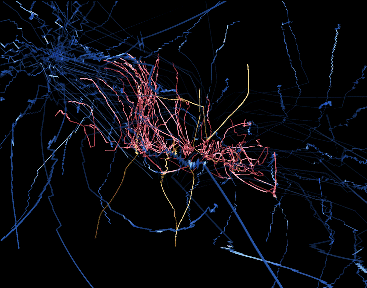
Art, Science and Research
The end of the C20th and the start of the C21st has seen an upsurge of interest in the relationship between art and science. This has been reflected in Sci-Art and related initiatives. It has also seen an increasing number of artists engaging in academic research. The reasons for this are complex and a part of the zeigeist. I therefore consider it important to explain my position on the matter.
My research is often related to my art but there is a fundamental difference between my practice as an artist and my academic research. This is inevitable, because there is a fundamental difference between art practice and its products and research and its products. In a very real sense the differences between the activities and the products of both complement each other and validate their contribution to the quality of human life. But they and their contributions are different.
Sometimes I use my works of art as case studies in my research and, as some of my art work is in part an homage to scientific visualisation, it may appear that my art is being presented as academic research but this is far from the truth. The two activities and their products are legitimised and evaluated very differently. Their goals are also different. Consequently it is possible to identify differences in my research and my art.

My work as an artist is driven by reactions to particular visual and other phenomena, particularly forms, shapes, patterns and rhythms made and implied by complex dynamic interactive situations like plant growth, human and animal social interaction and interactions between humans and their environments. This results in abstract works of art to be experienced and understood aesthetically and intellectually. I believe that promoting the unmediated easthetic understanding, and occasionally enjoyment of such complex visual phenomena will help us orient ourselves as humans in a complex and rapidly changing world. My art is intended to be understood in the way that we apprehend all works of art, which are exhibited publicly and privately, as art not as research. When I started doing this work back in the 1970's there were very few of us making this kind of art work. Since then an enormous number of artists, professional and amateur, have begun producing similar work. If my work has in any way influenced other artists to create similar types of work then it means that it is more likely that others will join me in this awesome task which all humans face - placing ourselves in the universe in that short moment of time when we have life.
My work as a researcher has been related to how computer graphics can influence the way we design things, particularly works of art and how we interact with computers, data and each other. I am also interested in how we use abstract patterns to make sense of our experiences and structure our interactions. It results, if succesful, in well-established types of research publication - conference papers, journal articles, book chapters, etc.. Unlike my art, this work is intended to be comprehended in the way that research is - consciously and mediated by carefully contextualising critical argument. With the emergence of research methodologies derived from art and design practice I have also spent some time researching practice related research methodologies.
In my PhD research I investigated the potential of interactive computer technology in participatory art, using my own work as a case study. This was to understand human-computer interaction in participatory contexts in general, including practical as well as other uses. By focusing on the artistic use of interaction I aimed to generate knowledge that could be applied in the broader field of interactive computer applications. I concluded at the time that people making participatory work of the kind are like a composer writing a score that can then be performed. My PhD thesis identified some of the things that can be composed in such works and argued that this understanding could be applied to the design and analysis of programmed interactive participatory experiences.
The philosophy of the NCCA has been to marry art and science to contribute to the development of several emerging disciplines including computer animation, digital effects and computer games. As well as being active both as an artist, having had a number of exhibitons and having done research in computer science to achieve a PhD, I also spent several years working in architecture research and education. Thus I have been able to apply my experience of teaching and research in art, science and design disciplines to solving the educational challenge of the developing courses at the NCCA and contributing to this exciting development of new disciplines through inter-disciplinary cooperation over more than twenty-five years.